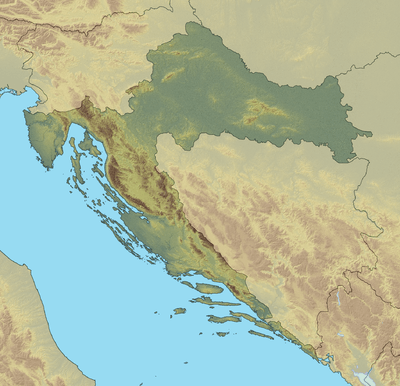Krapina Neanderthal site
Krapina Neanderthal Site, also known as Hušnjakovo brdo (Croatian for Hušnjakovo hill) is a Palaeolithic site found in 1899 which has the largest number of Neanderthal fossil bones found in Central Europe in 1899. It was excavated by Dragutin Gorjanović-Kramberger.[1]
Hušnjakovo brdo | |
Hušnjakovo Hill finding site | |
 location in Croatia  Krapina Neanderthal site (Croatia) | |
| Location | western part of Krapina city |
|---|---|
| Region | Krapina-Zagorje County, Croatia |
| Coordinates | 46°9′53″N 15°51′49″E |
| History | |
| Periods | Palaeolithic |
| Associated with | Neanderthals |
| Site notes | |
| Excavation dates | 1970 |
| Archaeologists | Dragutin Gorjanović-Kramberger |
| Management | [[]] |


It is located in the western part of Krapina. It has been declared a paleontological monument of nature. It is an important paleontological, paleoanthropological and archaeological site.[2]
This site enabled experts from all over the world to conduct research and elaborate scientific theories about human development and how human communities in Europe lived during at the beginning of the Late Pleistocene.[3]
Museum
Close to this archaeological site a museum presents the origin of life on Earth and the evolution of humankind.[4] It is situated in a park with statues of Neanderthals and contemporary fauna, such as a bear, a moose and a beaver set in the actual locations.[5]
References
- http://paleoanthro.org/dissertations/krapina-bibliography.pdf The Krapina Neandertals. A Comprehensive, Centennial, Illustrated Bibliography
- "Culturenet.hr - The World's Largest Neanderthal Finding Site". Culturenet.hr. Retrieved February 8, 2017.
- "Penn Museum - Analysis of the Dentition and Trauma of the Krapina Neanderthals". penn.museum. Retrieved February 8, 2017.
- "Muzej krapinskih neanadertalaca". Mkn.mhz.hr. 2010-02-27. Retrieved 2013-03-26.
- "Krapina Neanderthal Museum - Ice Age Europe". Ice-age-europe.eu. Retrieved February 8, 2017.
{